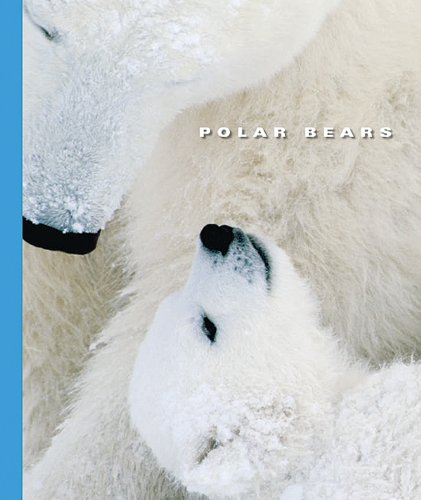-
Polar Bear Babies
Susan Ring, Lisa McCue
Paperback (Random House Books for Young Readers, Sept. 13, 2016)In this Step 1 Step into Reading Science Reader, polar bear babies learn the skills they will need to survive in the Arctic! Simple, repetitive text takes readers through a day with these little bears as they learn to fish, swim, and . . . run! Sweet, approachable art and a touch of excitement make this an ideal reader for curious little animal enthusiasts. Step 1 Readers feature big type and easy words. Rhymes and rhythmic text paired with picture clues help children decode the story. These books are for children who know the alphabet and are eager to begin reading. F
F
-
Polar Bears
Mark Newman
Paperback (Square Fish, Nov. 17, 2015)Whose fur isn't really white?Who usually gives birth to twins?Who's the biggest bear in the world?The Polar Bear!Full of fascinating information, this book explores the world of the polar bear on land and under water. Get ready to be wooed by adorable baby cubs and impressed by majestic adult bears captured in stunning photographs by renowned wildlife photographer Mark Newman. N
N
-
Polar Bears
Sophie Lockwood
language (The Child's World, Inc., Jan. 1, 2014)Equipped to survive the frigid arctic tundra, polar bears are powerful swimmers and agile hunters. Learn about the lives of these incredible mammals and how they manage to stay at the top of the food chain in their wintry habitat. Discover how threats such as global warming and oil spills pose a danger to them, and find out the role people play in enabling their survival.
-
Polar Bears
Emily Rose Townsend
Paperback (Capstone Press, Sept. 1, 2006)Photographs and text introduce the characteristics and behavior of polar bears and their habitat in the Arctic. H
H
-
Polar Bears
Gail Gibbons
Paperback (Holiday House, Sept. 1, 2002)The polar bear is the biggest and most powerful of the animals that are able to survive the hostile climate of the Arctic. Cubs are born during the cold dark winter, even though they start out with only a thin coat of fur and weigh a little over one pound. The mothers raise and teach them so they may grow and survive in the wild. Here is information about how polar bears swim and hunt, how they keep warm and dry, and the many other ways they adapt to their environment. O
O
-
Polar Bears
Kathy Allen
eBook (Capstone Press, Dec. 21, 2015)Cute and cuddly yet powerful and fierce, polar bears are loved by people around the world. But the great bear of the north is in trouble. Its habitat is disappearing, and its food supply is dwindling. Learn more about these amazing animals, their Arctic homes, what the eat, and what you can do to help.
-
Polar Bears
Rachael Hanel
Library Binding (Creative Education, Aug. 1, 2009)Learn about polar bears and their natural habitat. N
N
-
Polar Bears
Cari Meister
language (Jump! Library, March 4, 2019)In Polar Bears, early readers will learn how polar bears survive in the wild. Vibrant, full-color photos and carefully leveled text will engage beginning readers as they discover how a polar bear hunts for food to feed its family. A labeled diagram helps readers identify a polar bear's body parts, while a picture glossary reinforces new vocabulary. Children can learn more about polar bears online using our safe search engine that provides relevant, age-appropriate websites. Polar Bears also features reading tips for teachers and parents, a table of contents, and an index. Polar Bears is part of Jump!’s My First Animal Library series.
-
Polar Bears
Jacqueline S. Cotton
Paperback (First Avenue Editions TM, Jan. 1, 2004)Living in the icy cold of the Arctic, polar bears keep warm because they have thick white fur all over their bodies―even on the bottoms of their feet! They hunt and eat other animals, mostly seals. Small cubs drink their mother’s milk to help them grow into full-grown polar bears. K
K
-
Polar Bears
Maeve T. Sisk
Paperback (Gareth Stevens Leveled Readers, Aug. 15, 2010)Imagine living in one of the coldest places on Earththe Arctic. This book introduces readers to a regular and interesting inhabitant of the Arctic, the polar bear. Theyre huge meat-eating roamers of the harsh tundra, especially suited to a life on ice-covered terrain and in frigid waters. Fact boxes share supporting information, and the narrative highlights concerns about the future of polar bears on Earth. N
N
-
Polar Bears
Kari Schuetz
Library Binding (Bellwether Media, Aug. 1, 2011)Polar bears have thick fur and plenty of fat to keep them warm in their arctic homes. Their white coats also serve as good camouflage in snow-covered habitats. This book explores how polar bears prey on seals and use their paws to paddle through water! L
L
-
Baby Polar Bears
Bobbie Kalman
Paperback (Crabtree Pub Co, Sept. 1, 2010)Introduces polar bears and their young, describing physical characteristics, life cycle, habitat, and the caring behavior of mother polar bears. O
O